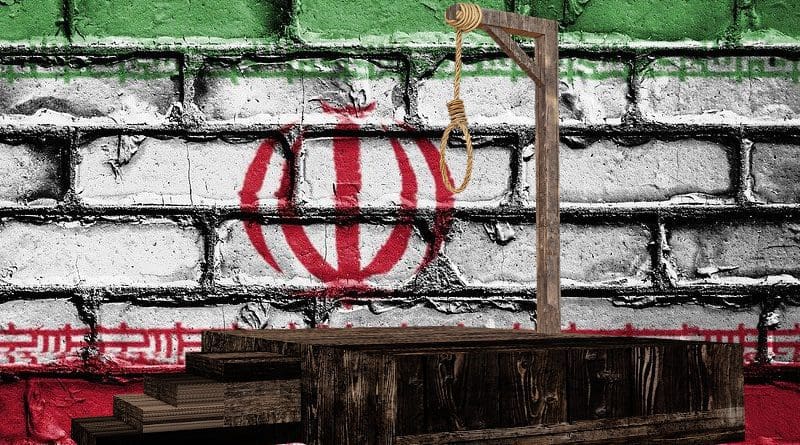Iran’s Record Of Execution For First Six Months Of 2020 – OpEd
While most countries have announced their opposition to the death penalty. The ruling dictatorship in Iran, regardless of this global demand to maintain its rule continues to arrest and execute people at a faster pace than last year. Amnesty International ranks Iran second in the number of executions, responsible for more than a third of total executions recorded in the world in 2019.
In the first six months of 2020 in Iran, 136 prisoners were executed in various prisons. There were 134 men 2 women. Some were teenagers under 18 at the time of committing a crime. The execution of this number of prisoners shows Mullahs’ fear of growing public discontent. These Mullahs want to prevent another popular uprising, especially now with approaching the anniversary of the November 2019 uprising. Recently there are a lot of calls to commemorate that event on social media. The mullahs and IRGC trying to restrain the people and not lose their grip on power have no choice but to suppress and kill.
For this reason, in addition to killing 128 ordinary people who had committed some crimes, such as drug trafficking due to their living conditions created by Mullahs, it also executed nine prisoners for their links to the uprising against the government in order to spread fear among the public.
In addition, physical and psychological torture is widely used informal and informal prisons in Iran, as shown below:
- physical and mental torture of Afkari brothers in Shiraz prison to obtain forced confessions, which eventually led to the death sentence and execution of Navid Afkari.
- Salem Zand died in Zahedan Central Prison because of beating by prison officials.
- Khaled Pirzadeh was tortured in Tehran prison by prison officials.
- Salahuddin Issazadeh was killed in Naghadeh prison by IRGC.
- Killing of 3 Koolbars named Zanest Hassan Nejad – Zanko Ahmadi and Soroush Malekari who were arrested in Sardasht then tortured and finally faced the firing squad.
- Depriving Sasan Niknafs, a civil activist, of medical treatment in Tehran Prison.
- Ali Mohammadi Moghadam, who committed suicide several times in Urmia Central Prison due to the harsh prison conditions and harassment.
- Depriving other prisoners such as Saba Kordafshari and Sharmin Meymandinejad of medical treatment.
- Matlab Ahmadian in Gohardasht Prison has lost the ability to move her legs due to a lack of medical care.
- Depriving Fatemeh Mussanna and Mohammad Nourizad of medical treatment in the hospital and Dr. Nasser Fahimi, who has been denied access to medical services after 10 years in prison.
Execution of 8 political prisoners:
- Mostafa Salimi was executed on October 11 in Saghez Central Prison.
- Abdul Basit Dahani was hanged on April 23 in Zahedan Prison.
- Shahram Baygan was executed on April 23 in Tabriz Central Prison.
- Hedayat Abdollahpour was executed on May 21 in Oshnaviyeh.
- Diako Rasoulzadeh was executed on July 14 in Kermanshah Central Prison.
- Saber Sheikh Abdullah was hanged on July 14 in Kermanshah Central Prison.
- Mostafa Salehi was executed on August 5 in Isfahan Central Prison.
- Navid Afkari, on September 12, even though in a campaign against his execution in Iran and other countries, thousands of artists, athletes and politicians, and even US President, called on Mullahs’ regime to stop Navid’s execution, on Khamenei’s direct behest hastily executed him because Khamenei sees execution as the mean for his survival.
Suicide and death of prisoners due to the pressure of prison guards and harsh conditions of prisons:
In the regime’s prisons and detention centers, a significant number of prisoners committed suicide, and some died due to illness and lack of medical care, below are some examples:
- In Urmia Central Prison, 20 prisoners committed suicide and died within two weeks.
- Danial Mohammadi, a 25-year-old prisoner in Isfahan’s Dastgerd prison, due to pressure by prison officials and being sent from a youth ward to an adult ward and the problems he faced in adult ward, committed suicide, and died.
- Ismail Mostakhdem, a prisoner in Bukan Prison who had been in prison for 12 years and was due to be released within a few days, died of lack of care for his illness.
- Maryam Ebrahimvand, a writer, director, and film producer who has been kept without trial in Evin Prison committed suicide.
- Mahmoud Taheri, a prisoner in Karaj Central Prison, died of an illness.
Execution of underage
During this period, three teenagers named Shayan Saeedpour in Saghez prison, Majid Esmailzadeh in Ardabil – and Arsalan Yassini in Urmia were executed. UN High Commissioner for Human Rights Michelle Bachelet strongly protested the execution of Shayan Saeedpour and Majid Ismailzadeh, two underage offenders in Iran. She called the execution of the two teenagers a violation of international human rights law and said that various UN agencies had repeatedly emphasized to Iran that the death penalty was strictly prohibited for offenders under the age of 18 at the time of the crime.
Two UN special rapporteurs on human rights, Javid Rahman and Agnès Callamard also called the execution of Shayan Saeedpour a violation of international law.
Where do these executions lead to?
Although these executions may create an atmosphere of fear among the people in the short term, it will certainly not be long before these executions feed the overthrow of the regime itself by millions of people who want to overthrow the regime and stop these executions. This does not seem to be far off.

